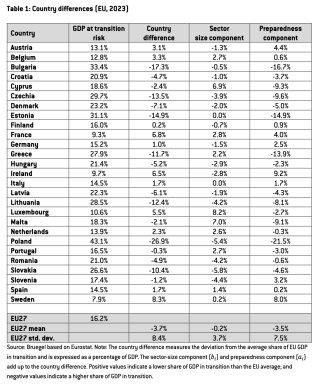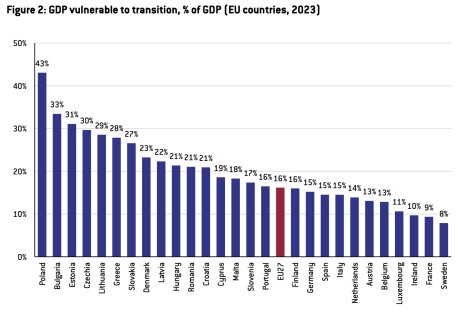Low-carbon transition: 16% of EU GDP at risk, 9% in France, 43% in Poland (Bruegel study)
"We find that Sweden and France have low shares of GDP
Gross Domestic Product
facing transition risk (8 and 9%), while Poland and Bulgaria have high shares of GDP
Gross Domestic Product
facing transition risk (43 and 33%). The main driver is a country’s carbon intensity, the main dynamics are its transition preparedness", outline the authors of study titled "Measuring GDP at risk in the low-carbon transition" and published by the Bruegel think-tank on 25/08/2025.
"Our results indicate the potential losses in GDP when the energy transition happens. Countries may adopt mixed strategies of speeding up transition in certain sectors and slowing it down in others, but they cannot insulate sectors from transition pressure forever. At some point, high-carbon sectors will become obsolete, leading to lost GDP. The policy challenge is to reduce GDP exposures to the energy transition", they continue.
This study advises countries and policy-makers to:
• Stimulate change towards low-carbon activities with a combination of taxes for high-carbon technologies and R&D
Research & Development
subsidies for low-carbon technologies;
• Accelerate reallocation of labour towards low-carbon technologies and sectors by investing in education and retraining.
What shares of national GDP are vulnerable to transition?
The two-step model in Bruegel's study identifies sectors that need to transition to survive in a specific country and then analyzes their preparedness. The result is the country's exposure to transition. They provide a case study in EU countries towards energy transition.
Main findings
• The EU has an exposure to energy transition of 16.2% of GDP as a whole, with strong disparities between countries.
• Sweden and France are well prepared for the energy transition, with very low exposures of 7.9% and 9.3% of GDP, respectively, because their economies rely on relatively low carbon intensities.
• Poland and Bulgaria have the highest carbon intensities among EU countries, with respective exposures to the energy transition of 43.1% and 33.4% of GDP.
• Throughout Scandinavian countries, "which usually top any sustainability ranking, Denmark doesn't live up to this picture, with 23.2% of GDP exposure to the energy transition, mainly because of its large shipping sector, which has a very high carbon intensity", point the authors of the study.
• Some smaller countries, including Luxembourg, Cyprus and Malta, which are more services-oriented (finance, tourism), are less exposed to the energy transition (10.6%, 18.6% and 18.3% respectively), because their industrial sector is smaller.

The variations are explained by the share of the industrial sector in the GDP, but also by the preparedness of countries.
• Ireland, Sweden, Austria, and France have relatively high transition preparedness based on low carbon intensities.
- Sweden and France top the country ranking, partly because of their advantages with hydro and nuclear power, and also because of high carbon taxes in Sweden.
• By contrast, Bulgaria, Estonia, Greece, and Poland have very high carbon intensities, translating into very low transition preparedness.
- Poland and Bulgaria still make heavy use of coal in power generation and high-heat industrial processes, although Poland is moving fast, with its coal power generation reducing from 70% in 2022 to 54% in 2024.

